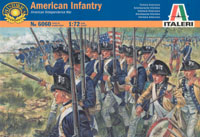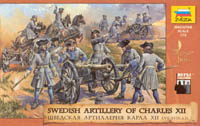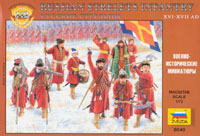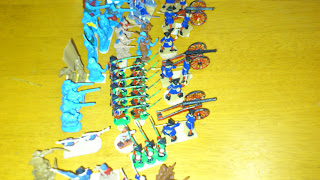 While not quite historically accurate, I included members of the "Wild Geese" known in this campaign as the Irish Picquetes. Companies from the Irish regiments in the French army were sent over to Scotland in order to pin down British regiments from fighting on the continent. The use of "French" troops was quite successful as a contingent of Dutch troops which were aiding the British were forced to retire as part of their parole after their capture was to ensure they would not fight French troops. Since the Irish were part of the French army, they were obliged to withdrawal from the fighting.
While not quite historically accurate, I included members of the "Wild Geese" known in this campaign as the Irish Picquetes. Companies from the Irish regiments in the French army were sent over to Scotland in order to pin down British regiments from fighting on the continent. The use of "French" troops was quite successful as a contingent of Dutch troops which were aiding the British were forced to retire as part of their parole after their capture was to ensure they would not fight French troops. Since the Irish were part of the French army, they were obliged to withdrawal from the fighting.A blog on War gaming in North-eastern North America from 1670-1815, the life of an ex EFL instructor, a family man formerly in Japan and now in Canada , a camper, a reenactor, a drummer, and all round crazy but home Nova Scotian. Having taught for an extended period my career is now in private security.
Friday 30 December 2011
Prestonpans part 8
 While not quite historically accurate, I included members of the "Wild Geese" known in this campaign as the Irish Picquetes. Companies from the Irish regiments in the French army were sent over to Scotland in order to pin down British regiments from fighting on the continent. The use of "French" troops was quite successful as a contingent of Dutch troops which were aiding the British were forced to retire as part of their parole after their capture was to ensure they would not fight French troops. Since the Irish were part of the French army, they were obliged to withdrawal from the fighting.
While not quite historically accurate, I included members of the "Wild Geese" known in this campaign as the Irish Picquetes. Companies from the Irish regiments in the French army were sent over to Scotland in order to pin down British regiments from fighting on the continent. The use of "French" troops was quite successful as a contingent of Dutch troops which were aiding the British were forced to retire as part of their parole after their capture was to ensure they would not fight French troops. Since the Irish were part of the French army, they were obliged to withdrawal from the fighting.Prestonpans part 7
 The Jacobite line begins to Charge! The Jacobite main battle tactic was to advance close enough to their enemy to fire a volley with their muskets and pistols, then if any had them, draw their broadswords and charge at whoever was still standing. Recent historical evidence suggests that many of the Jacobite's did not carry broadswords, dirks or targes, but rather muskets which were supplied by the French and Spanish, or picked up at the end of this battle.
The Jacobite line begins to Charge! The Jacobite main battle tactic was to advance close enough to their enemy to fire a volley with their muskets and pistols, then if any had them, draw their broadswords and charge at whoever was still standing. Recent historical evidence suggests that many of the Jacobite's did not carry broadswords, dirks or targes, but rather muskets which were supplied by the French and Spanish, or picked up at the end of this battle. Prestonpans part 5
 Many of the British regiments which took part in the '45 would later go on to fight in the Seven Years War/French and Indian War in North America. The 44th and 46th Regiments were the unlucky ones as they had been defeated twice by the Jacobites then again by the Amerindians and Canadiens as part of Braddock's campaign in 1755.
Many of the British regiments which took part in the '45 would later go on to fight in the Seven Years War/French and Indian War in North America. The 44th and 46th Regiments were the unlucky ones as they had been defeated twice by the Jacobites then again by the Amerindians and Canadiens as part of Braddock's campaign in 1755.Prestonpans part 4
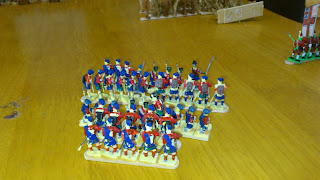 Despite what most of the general public believe, the 1745 rising was not just English against Scottish. There were by far more Scots fighting with King George II than for Prince Charles Edward Stuart. There were two Highland Regiments in the British army which fought in the '45. The 43rd Regiment later the 42nd Black Watch Royal Highland Regiment, and the 64th Regiment Loudoun's Highlanders. These "Highlanders" are Airfix Waterloo Highlanders which were altered with a modelling knife, a lighter (don't try that at home kiddies unless Daddy is holding it) and painting.
Despite what most of the general public believe, the 1745 rising was not just English against Scottish. There were by far more Scots fighting with King George II than for Prince Charles Edward Stuart. There were two Highland Regiments in the British army which fought in the '45. The 43rd Regiment later the 42nd Black Watch Royal Highland Regiment, and the 64th Regiment Loudoun's Highlanders. These "Highlanders" are Airfix Waterloo Highlanders which were altered with a modelling knife, a lighter (don't try that at home kiddies unless Daddy is holding it) and painting. Prestonpans part 3
Prestonpans part 2
 Both Osprey publications on this battle note that it was one of the first recorded success of infantry charging cavalry! When the Jacobites charged the British line, they accidently parted their line as they charged. Rather than hitting the infantry to their front, they actually hit the cavalry on the flanks. The British horse was rather suprised and bolted. Once this happened, the Jacobites then turned in on the British infantry who being rather poorly trained and having the psychological effect of a Highland charge in turn ran.
Both Osprey publications on this battle note that it was one of the first recorded success of infantry charging cavalry! When the Jacobites charged the British line, they accidently parted their line as they charged. Rather than hitting the infantry to their front, they actually hit the cavalry on the flanks. The British horse was rather suprised and bolted. Once this happened, the Jacobites then turned in on the British infantry who being rather poorly trained and having the psychological effect of a Highland charge in turn ran. The Battle of Prestonpans 1745
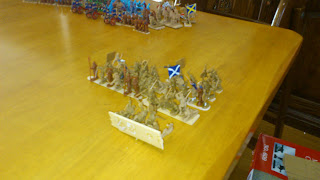 From Reid's Culloden 1746, Prestonpans was an interesting battle as it was not fought in the highlands of Scotland but in a pre-industrial setting in suburban Edinburgh. The battle is most famous for the British Commander Sir John Cope losing, then retreating and reporting his own defeat to his superior. In Highland lore and Highland Regiments traditions, the pipe tune Hey Johnny Cope depicts this battle as one where the Jacobite's had surprised the British army while they slept. This wasn't necessarily the case, but it was a coup by the Jacobite's. They were able to defeat a modern army.
From Reid's Culloden 1746, Prestonpans was an interesting battle as it was not fought in the highlands of Scotland but in a pre-industrial setting in suburban Edinburgh. The battle is most famous for the British Commander Sir John Cope losing, then retreating and reporting his own defeat to his superior. In Highland lore and Highland Regiments traditions, the pipe tune Hey Johnny Cope depicts this battle as one where the Jacobite's had surprised the British army while they slept. This wasn't necessarily the case, but it was a coup by the Jacobite's. They were able to defeat a modern army.How our reenacting all began
 In 1984, the first 18th century reenactment unit (outside of Parks Canada) was formed for the bicentenial of the United Empire Loyalists migration to British North America from 1783-85. Our choice of regiment to portray was the 2nd Battalion 84th Regiment, Royal Highland Emigrants. We chose this unit as it had settled in the are where we lived, notibly Colchester, Hants and Halifax counties of Nova Scotia. Our uniforms were a mix bag of garmets which we had altered to look the part of the 18th century. Over time, our group of 5 members has grown to a sizable group which I believe is now about 30-40 members from all areas of Nova Scotia. Eventually in the mid 1990's other units were formed, The King's Orange Rangers out of Liverpool, The Royal Fencible Americans in Halifax, The Prince of Wales Volunteers and the 3rd Battalion New Jersey Volunteers. There is also a detachment of the 4th Battalion Royal Artillery as well as some members who also portray Goreham's Rangers, 78th Fraser's Highlanders Grenadier Company.
In 1984, the first 18th century reenactment unit (outside of Parks Canada) was formed for the bicentenial of the United Empire Loyalists migration to British North America from 1783-85. Our choice of regiment to portray was the 2nd Battalion 84th Regiment, Royal Highland Emigrants. We chose this unit as it had settled in the are where we lived, notibly Colchester, Hants and Halifax counties of Nova Scotia. Our uniforms were a mix bag of garmets which we had altered to look the part of the 18th century. Over time, our group of 5 members has grown to a sizable group which I believe is now about 30-40 members from all areas of Nova Scotia. Eventually in the mid 1990's other units were formed, The King's Orange Rangers out of Liverpool, The Royal Fencible Americans in Halifax, The Prince of Wales Volunteers and the 3rd Battalion New Jersey Volunteers. There is also a detachment of the 4th Battalion Royal Artillery as well as some members who also portray Goreham's Rangers, 78th Fraser's Highlanders Grenadier Company.  During my univeristy studies, I also applied and was accepted to work with the Halifax Citadel Regimental Association as a member of 78th Rosshire Buffs and the 3rd Brigade Royal Artillery 1869-71. I was a basic private in the infantry and a gunner in the artillery. This was definetly a cool job to work in for someone who was a reenactor from their youth as well as a history major in university.
During my univeristy studies, I also applied and was accepted to work with the Halifax Citadel Regimental Association as a member of 78th Rosshire Buffs and the 3rd Brigade Royal Artillery 1869-71. I was a basic private in the infantry and a gunner in the artillery. This was definetly a cool job to work in for someone who was a reenactor from their youth as well as a history major in university.Painting guides, sources of inspiration
The Seven Years War website: http://kronoskaf.com/syw/index
Canadian Military Heritage Group website: www.cmhg.gc.ca
Flintlock and Tomahawk blog
Tarleton’s Quarter blog
Osprey Publishing books: Many of these book my father and I have collected since Osprey publishing began in the mid 1970's.
MAA 460 Frederick the Great’s Allies 1756-63 (Reid 2010)
MAA 366 Colonial American Troops (1) 1610-1774 (Chartrand, 2002)
MAA Colonial American Troops (2) 1610-1774 (Chartrand, 2002)
MAA Colonial American Troops (3) 1610-1774 (Chartrand, 2002)
MAA 48 Wolfe’s Army (May 1974)
MAA Montcalm’s Army (Winndrow 1973)
MAA 273 George Washington’s Army (1)
MAA 290 George Washington’s Army (2)
MAA 39 The British Army in North America 1775-1783 (2 copies)
MAA 244 French Army in American War of Independence (Chartrand)
MAA The Black Watch
MAA The Argyle and Sutherland Highlanders
MAA 228 American Woodland Indians
MAA 285 King George’s Army (1) (Reid)
MAA 289 King George’s Army (2) (Reid)
MAA 292 King George’s Army (3) (Reid)
MAA 261 18th Century Highlanders (Reid)
MAA The Jacobite Rebellions 1689-1746 ()
MAA 302 LouisXV’s Army (2) French Infantry (Chartrand 1997)
MAA 313 Louis XV’s Army (5) Colonial and Naval Troops (Chartrand 1997)
MAA 450 American Loyalist Troops 1775-1784 (Chartrand 2008)
MAA The Wild Geese (1980)
MAA 279 The Border Reivers
MAA 118 The Jacobite Rebellions 1689-1745
MAA 260 Peter The Great’s Army 1 Infantry
MAA 264 Peter the Great’s Army 2 Cavalry
WAR Samurai 1550-1600 (Turnbull 1995)
WAR Highland Clansman 1689-1746 (Reid)
WAR British Redcoat (Reid)
WAR 85 American Colonial Ranger 1724-64 (Zaboly)
WAR British Light Infantryman in the Seven Years War (Macallum/Todish)
WAR 126 Highlander in the French-Indian War 1756-67 (Macallum)
CAM Culloden 1746 The Highland Clans Last Charge ()
CAM Culloden 1746 (Reid)
CAM Monongahela 1754-55 Washington’s Defeat, Braddock’s diaster
CAM Louisbourg 1758 Wolfe’s First Siege (Chartrand)
CAM Ticonderoga 1758 (Chartrand)
CAM 121 Quebec 1759 (Reid 2003)
CAM 135 Monmouth Courthouse 1778 (Morrissey 2004)
CAM 2 Austerlitz 1805 Battle of the Three Emperors (Chandler 1990)
CAM Jena 1806 Napoleon crushes Prussia (Chandler )
CAM 48 Salamanca 1812 Wellington Crushes Marmont (Fletcher 1997)
CAM Leipzig 1813
CAM New Orleans 1815 (Knight)
ELE American Revolutionary War Commanders (Chartrand)
ELE British Colours & Standards 1747-1881 (1) Cavalry (Summer 2001)
ELE 149 The Scottish Jacobite Army 1745-46 (Reid 2006)
ODR 3 Quebec 1759 (Chartrand 1999)
FOG 6 Cities of Gold Africa and the Americas 1494-1698 (2011)
Fort Dusequene
Raid on Fort Duquesne September 9, 1758 Refought 12/18/11
Major Grant advanced his troops carefully along the Alleghany river to his objective. The colonial rangers were providing a forward cover while the 77th Highlanders made up the first units of his advance. The Grenadier companies were dispersed along the length of the collum. The other provincial units held the rear while the British regulars made up the centre. The French commander sent out his entire force to halt the British advance. As the Highlanders broke forth from a clearing, Les Compaignes Frances briskly advanced, fired a volley and then charged the dazed Highlanders. The rangers were then taken out by Canadien milice while the Amerindians headed straight for the regulars. The American colonials charged forth and poured a heavy volley which made most of the Amerindians flee. Eventually a French officer rallied them and then they went back to harass the regulars. The French kept up the pressure on the British line. While the provincials had cleared the way, the milice and Amerindians simply turned inward and cut them down. The British were forced into a defensive square where the commander decided to risk surrendering to the French commander. Once again, the French had blunted another advance on Ft. Duquesne.
Thursday 29 December 2011
The Battle of Lake George
1. Battle of Lake George 1755
British Forces: French Forces:
Sir William Johnson’s New England Regt. La Reine
Army Compaigne Frances
Milice du Quebec
Hurons/Abenaki
Johnson established a fortified camp on the shores of Lake George prior to Baron Diskeau’s arrival. The German general in the service of France was faced with a problem. His Amerindian allies would not fight unless given chance to plunder. The Baron decided that if this was to be allowed, no quarter was to be given to the English colonial force. As his artillery provided covering fire, the French advanced as a collum against the camp. As the Amerindians overran one area of the camp, the French smashed into the defenses. The battle decended into an orgy of violence and blood. No colonials were left alive. Johnson was decapitated and his head put on a stake in the middle of his camp. If the colonials wanted to challenge the Ameindians again, this was what they would expect. The French washed their hands of the affair. Diskeau would ultilize the policy which the French used in Holland fifty years before. If the colonials were terrifired of the Amerindians before, they most surely be cowered now.
Wednesday 28 December 2011
Monmouth 6
Monmouth Courthouse Battlefield looking from the British position towards the Americans. The windmill is another 100 yen shop special.
Monmouth5
The American horse. The house are templates from www.juniorgeneral.org and the ruined house is from a 100 yen shop here in Japan. The stone wall is actually the chimmney from the tavern template from the wizards of the coast website.
Monmouth4
The British Right wing advances. The figures are a mix of IMEX, HaT, Italeri, and A Call to Arms. The flags are from www.warflag.com
Monmouth3
The British line advances. My little boy insisted on putting his pike and shot figures in the game, they did better than the British infantry and Highlanders to their front.
Monmouth2
The British horse advance on the Americans
Battle of Monmouth June 28, 1778
This was the largest battle in the Northern area during the American Revolution. 11,000 American troops attempted to destroy 10,000 British troops. It was General Lee's downfall and Washington was able to save his army from another defeat.
The Refight with miniatures 12/27/11
Crown Forces Continental Army
First Division: Gen. Cornwallis Gen. Lee
Royal Artillery Continental Artillery
16th Lt. Dragoons Col. Grayson’s Det
1st Light Infantry 4th/8th/12th Virginia
Queens Rangers Col. Durkee’s Det
4th/8th Connecticut
British Grenadiers 1st/2nd/ Rhode Island
1st Grenadiers Gen Maxwell
2nd Grenadiers 1st New Jersey
3rd New Jersey
Foot Guards Monmouth Militia
3rd Bde. Poor’s Bde
15th/17th/42nd/44th 1st New Hampshire
4th Bde. 3rd New Hampshire
33rd/37th/46th/64th/ 2nd New York
5th Bde. Huntington Bde.
7th/26th/63rd/ 2nd/5th Connecticut
Smallwood Bde.
Second Division Gen. von Knyphausen 3rd Maryland
Flank Guards 2nd Maryland
17th Lt. Dragoons/2nd Lt. Inf/ 40th 6th Maryland
Parkers Bde
Jagers 1st/5th/9th Virginia
1st Bde. Lord Stirling Bde
4th/23rd/28th/49th/ 1st Pennsylvania
2nd Bde. 2nd Pennsylvania
5th/10th/27th/55th 7th Pennsylvania
Hessian Bde. Butler’s Bde
Loyalist Corps 4th Pennsylvania
Maryland Loyalists 5th Pennsylvania
New Jersey Volunteers 11th Pennsylvania
1st New York
Glover’s Bde
1st/4th/10th Massachusetts
Monmouth 1
Santa was generous to us this year, on the wargamming front. IMEX The Battle of Monmouth Courthouse set. 200 British and American troops plus the Jacobite Highlanders and English civil war figures which my son wanted made quite an impressive apprearance on the kitchen table. Other figures which I painted were Italeri Napoleonic British Hussars as Queen's Rangers Hussars,
The landscaping effects come from www.juniorgeneral.org as well as a link to Wizards of the Coast for templates for buildings. I believe the cabin came from a link via http://flintlockandtomahawk.blogspot.com
The landscaping effects come from www.juniorgeneral.org as well as a link to Wizards of the Coast for templates for buildings. I believe the cabin came from a link via http://flintlockandtomahawk.blogspot.com
Monday 26 December 2011
Trois Riverier
 New France had 3 main militia districts. Quebec with Red caps, Montreal with Blue and Trois Riverier with white. These figures are based off Zeveda's Strelets. The uniforms and weapons may seem a little out of place on the Canadian battlefield but when you have limited supplies of figures, you have to improvise. Plus, the Canadian winter can be quite cold such as -45c! And that's without taking into account of the windchill. At 20km winds this can then feel lik -60c!
New France had 3 main militia districts. Quebec with Red caps, Montreal with Blue and Trois Riverier with white. These figures are based off Zeveda's Strelets. The uniforms and weapons may seem a little out of place on the Canadian battlefield but when you have limited supplies of figures, you have to improvise. Plus, the Canadian winter can be quite cold such as -45c! And that's without taking into account of the windchill. At 20km winds this can then feel lik -60c!4th Massachusetts, 1779
More American
American colours
Compaigne Frances de La Marine
 Prior to 1755, these were the only troops France had in Acadie and New France. The officers were usually Canadiens but the rank and file were recruited in metropolotian France. The officer I have painted as one found in Acadia circa 1690-1710 while the colors are based off of the Louisbourg garrison of 1740.
Prior to 1755, these were the only troops France had in Acadie and New France. The officers were usually Canadiens but the rank and file were recruited in metropolotian France. The officer I have painted as one found in Acadia circa 1690-1710 while the colors are based off of the Louisbourg garrison of 1740.Sunday 25 December 2011
Cannonier-Bombardier
Amerindians allied with the French
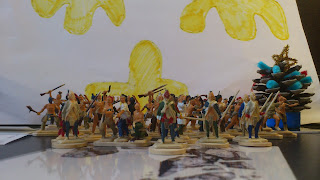 These are the Italeri Native warriors as part of their American War of Independence series. Just to add to the Christmas spirit, my son added his daycare craft for a festive touch. Merry Christmas to all and to all a good night
These are the Italeri Native warriors as part of their American War of Independence series. Just to add to the Christmas spirit, my son added his daycare craft for a festive touch. Merry Christmas to all and to all a good nightFriday 23 December 2011
It was Christmas Eve in the trenches, enter the French
It's the day before the big day for family and friends to enjoy Christmas, eat, sleep, be merry, then clean everything up.
 And here's the rest of my son's Spanish contingent. They plan on taking on Virginians or Georgians in the 2012
I realized that I haven't posted too many pics of my French units so here they are.
And here's the rest of my son's Spanish contingent. They plan on taking on Virginians or Georgians in the 2012
I realized that I haven't posted too many pics of my French units so here they are.
Also to those of you who are following this blog, Merry Christmas and a Happy New Year from Japan
 And here's the rest of my son's Spanish contingent. They plan on taking on Virginians or Georgians in the 2012
And here's the rest of my son's Spanish contingent. They plan on taking on Virginians or Georgians in the 2012Also to those of you who are following this blog, Merry Christmas and a Happy New Year from Japan
Saturday 10 December 2011
Two weeks to the big day, the British await the arrival from Santa.
 Today's posting shows the Regiments I have painted up. Of course, the first shot is The 1st Regiment or Royal Scots. This Regiment served at the Siege of Louisbourg in 1758 then was moved to General Amherst's command in 1759
Today's posting shows the Regiments I have painted up. Of course, the first shot is The 1st Regiment or Royal Scots. This Regiment served at the Siege of Louisbourg in 1758 then was moved to General Amherst's command in 1759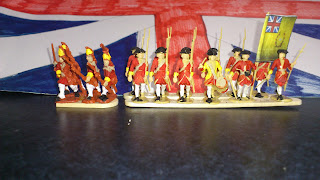 The 28th Regiment of Foot. This Regiment had served in Nova Scotia and Newfoundland in the late 1690's as Gibbon's Regiment. Those who stayed behind as Independent companies became...
The 28th Regiment of Foot. This Regiment had served in Nova Scotia and Newfoundland in the late 1690's as Gibbon's Regiment. Those who stayed behind as Independent companies became... The 42nd Royal Highland Regiment, The Black Watch. These beauties started life as Airfix Waterloo British Highlanders but with a lighter and modelling knife and paint have been transformed to 18th century Highlanders. As far as accuracy goes, at this scale my philosophy is if it looks like a duck, it is a duck.
The 42nd Royal Highland Regiment, The Black Watch. These beauties started life as Airfix Waterloo British Highlanders but with a lighter and modelling knife and paint have been transformed to 18th century Highlanders. As far as accuracy goes, at this scale my philosophy is if it looks like a duck, it is a duck. The 47th Regiment. When this Regiment served at Louisbourg, they had redcoats faced white. At Quebec, their resupply of uniforms had been captured by a French privateer. Instead of their usual uniform, they were issued uniforms which had been made for the disbanded 50th and 51st which were red faced red.
The 47th Regiment. When this Regiment served at Louisbourg, they had redcoats faced white. At Quebec, their resupply of uniforms had been captured by a French privateer. Instead of their usual uniform, they were issued uniforms which had been made for the disbanded 50th and 51st which were red faced red. The 78th Fraser's Highlanders. Another conversion of Airfix Highlanders. This Regiment served in the Louisbourg and Quebec campaigns while their Light Infantry companies served all over North America.
The 78th Fraser's Highlanders. Another conversion of Airfix Highlanders. This Regiment served in the Louisbourg and Quebec campaigns while their Light Infantry companies served all over North America. This shot is of my Royal Artillery and other figures who are as of yet are waiting for Santa to bring their brother's and sisters from the North Pole. There is also a sampling of Royal Navy gun crews here as well. A lone Ensign of the 58th awaits his regiment to rally around his Colours on Christmas morning.
This shot is of my Royal Artillery and other figures who are as of yet are waiting for Santa to bring their brother's and sisters from the North Pole. There is also a sampling of Royal Navy gun crews here as well. A lone Ensign of the 58th awaits his regiment to rally around his Colours on Christmas morning.
Subscribe to:
Posts (Atom)









 The Monmouth game from the American side
The Monmouth game from the American side











